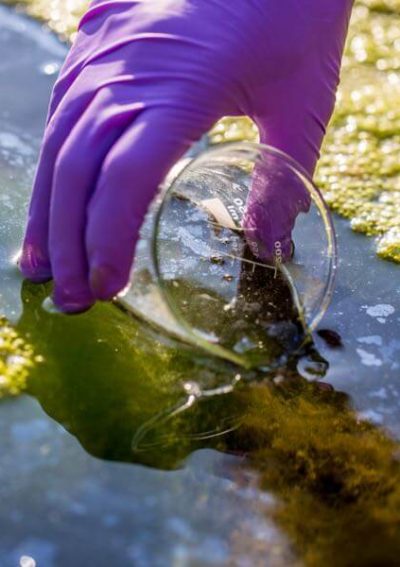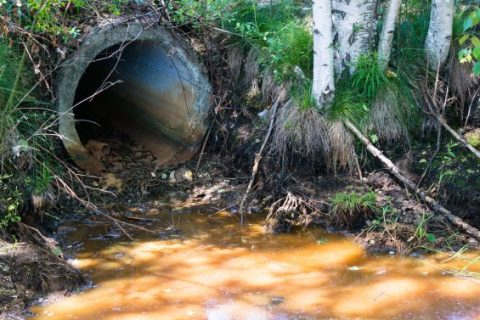Toxic Chemical Spills
A toxic chemical spill is an accidental release of a hazardous biological, synthetic or radiological substance into the air, water or land. Inhaling, drinking, bathing in or touching these chemicals can pose a significant health risk to the public, pets, livestock and wildlife.

Examples of Toxic Chemical Spills
In the first two months of 2023, there were at least 30 potentially dangerous chemical spills across the country, according to the Coalition to Prevent Chemical Disasters. In every year since 1993, the U.S. has reported more than 30,000 chemical and oil spills.
Although the most recent examples of dangerous chemical spills come from train derailments, spills happen in a variety of ways, from accidents to natural events to sabotage. Some spills are small and harmless. Others are disasters that require emergency evacuations.
- Ohio train derailment (Feb. 3, 2023): A 150-car derailment resulted in a toxic chemical spill and fire, causing a major health and environmental crisis after the hazardous chemicals contaminated the air, soil and water around the crash site.
- Keystone pipeline eruption (Dec. 7, 2022): The second-largest spill of tar sands crude on U.S. soil resulted in a $480 million clean-up with experts fearing for the long-term impact of the accident.
- Fire at a chemical plant in Louisiana (Oct. 15, 2022): An explosion and a fire at Sasol chemical plant in Louisiana led to a shelter-in-place directive to residents. An onsite emergency team contained the fire. No casualties, injuries or damage to off-site areas were reported.
- Hazmat incident in Jurupa Valley (Sept. 23, 2022): 7 civilians and 2 firefighters were hospitalized after an unknown caustic substance in a container recycling center released gas during a clearing by hazmat teams.
Residents of East Palestine, Ohio and surrounding areas have filed multiple lawsuits against Norfolk Southern Corporation following the recent Ohio train derailment. The suits allege negligence and carelessness not only for the accident but also for how it disposed of hazardous chemicals including vinyl chloride and benzene that spilled into the environment.
What Causes Chemical Spills?
Causes of chemical spills can be natural or human-caused. Natural causes include earthquakes, hurricanes, fires and volcanic eruptions. Human-caused events include industrial accidents or unsafe handling, improper storage, failure of storage containers and improper disposal.
During volcanic eruptions, for example, significant amounts of carbon dioxide, sulfur dioxide, hydrogen sulfide and hydrogen halides are emitted. Human activities such as oil spills can also release chemicals into the environment. The National Oceanic and Atmospheric Administration notes these can be the result of ship collisions, fuel transfer mishaps and catastrophic spill events.
- Acts of terrorism or chemical warfare
- Chemical storage facility explosions
- Oil spills
- Storage unit leaks during transport
Threats to human health stemming from chemical spills include outbreaks of disease associated with chemical exposure and contamination of the drinking water and food supply. The WHO identifies human-caused events – sometimes broadly called “technological events” – as the cause of an estimated 65,000 deaths between 2008 and 2018.
How Can Toxic Spills Impact Health?
Toxic chemical spills can cause severe breathing issues, genetic mutations, behavioral irregularities, birth defects, kidney failure and cause cancer. Reproduction can also be adversely affected.
In the Ohio train derailment incident, for example, vinyl chloride was among the released toxins that caused the most concern. The International Agency for Research on Cancer classifies vinyl chloride as a Group 1 carcinogen, meaning there is enough evidence to conclude it causes cancer in humans.Used to make PVC, vinyl chloride is also associated with eye irritation, respiratory damage and liver damage.
How Toxic Spills Impact the Environment
A toxic spill’s impact on environmental health depends on the amount and specific substances released. Leaks and spills can pollute the air, soil, surface water and groundwater.
As the NOAA notes, “The release of oil and chemicals into our coastal waterways can kill wildlife, destroy habitat, and contaminate critical resources in the food chain. Spills can also wreak havoc on the economies of coastal communities by forcing the closure of fisheries, driving away tourists, or temporarily shutting down navigation routes. And these environmental and economic damages can linger for decades.”
The largest marine oil spill in history was the 2010 BP Deepwater Horizon industrial disaster in the Gulf of Mexico. Petroleum leaked for five months after an oil rig explosion 41 miles off the coast of Louisiana. Gulf currents pushed oil and tar balls to beaches in Louisiana, Mississippi, Alabama and Florida, polluting 1,100 miles of shoreline. BP created a $20 billion fund to compensate victims and settled hundreds of lawsuits.
How to Prevent Chemical Spills
The United States Government Accountability Office’s 2022 report to Congress outlines recommendations to the Environmental Protection Agency to help prevent chemical spills. Recommendations include clarifying how to assess risks from natural disasters and climate change, designing a robust information system to track issues flagged in facility inspections and evaluating risks to communities from chemical spills.
While businesses and commercial organizations have lobbied against regulations designed to prevent toxic spills, labor organizations have voiced support for stronger rules. In October 2022 the International Union, United Automobile, Aerospace and Agricultural Implement Workers of America, for example, not only supported proposed Accidental Release Prevention Requirements, but proposed their own recommendations to the Office of Land and Emergency Management strengthen the requirements.
In January 2023, 16 U.S. Senators and 33 members of Congress wrote to the EPA to support the Safer Communities by Chemical Accident Prevention proposed rule. The elected officials also asked that the EPA take further steps to protect communities and workers. While commending the agency for recognizing “climate change as a threat multiplier,” they “encourage EPA to strengthen these provisions by also requiring implementation of mitigation measures to prevent these climate-related ‘double disasters,’ as emphasized in the GAO’s February 2022 report.”
Cleaning Up Chemical Spills
The EPA’s emergency response program coordinates with other programs within the agency, state and local authorities, the Army Corps. of Engineers and a variety of other organizations to help clean up chemical spills quickly and safely. The EPA responds to biological, chemical, radiological and nuclear incidents.
The NOAA is also charged with responding to hazardous spills through its Ocean Service’s Office of Response and Restoration. As the agency explains, “This office’s Emergency Response Division is often first on the scene, providing scientific expertise to predict where the spill is going and what impacts it might have, identifying resources at risk, and recommending clean-up methods.”
A federally established National Response System manages a National Response Center that serves as a call center for initial reports oil spills, chemical releases, railroad incidents and pollution. To report a chemical spill, call the National Response Center at 1-800-424-8802.
20 Cited Research Articles
Consumernotice.org adheres to the highest ethical standards for content production and references only credible sources of information, including government reports, interviews with experts, highly regarded nonprofit organizations, peer-reviewed journals, court records and academic organizations. You can learn more about our dedication to relevance, accuracy and transparency by reading our editorial policy.
- Perkins, T. (2023, March 17). Levels of carcinogenic chemical near Ohio derailment site far above safe limit. Retrieved from https://www.theguardian.com/us-news/2023/mar/17/norfolk-southern-derailment-east-palestine-ohio-carcinogenic-chemical-levels
- Backman, I. (2023, February 23). Ohio Chemical Spill: Is the Air Safe? Retrieved from https://medicine.yale.edu/news-article/ohio-chemical-spill-is-the-air-safe/
- U.S. Environmental Protection Agency. (2023, February 21). EPA Orders Norfolk Southern to Conduct All Cleanup Actions Associated with the East Palestine Train Derailment. Retrieved from https://www.epa.gov/newsreleases/epa-orders-norfolk-southern-conduct-all-cleanup-actions-associated-east-palestine
- Baker, J. (2023, February 20). Nine lawsuits filed so far against Norfolk Southern after train derailment. Retrieved from https://www.fox19.com/2023/02/20/nine-lawsuits-filed-so-far-against-norfolk-southern-after-train-derailment/
- Bendix, A. & Li, D. (2023, February 13). Worried residents near Ohio train derailment report dead fish and chickens as authorities say it's safe to return. Retrieved from https://www.nbcnews.com/health/health-news/residents-ohio-train-derailment-report-dead-fish-chickens-rcna70378
- U.S. Congress. (2023, January 25). Letter to EPA. Retrieved from https://www.booker.senate.gov/imo/media/doc/bicameral_epa_letter_on_chemical_disaster_proposed_rule_jan_2023.pdf
- U.S. Environmental Protection Agency. (2023, January 03). Health and Ecological Hazards Caused by Hazardous Substances. Retrieved from https://www.epa.gov/emergency-response/health-and-ecological-hazards-caused-hazardous-substances
- Fralish, M. & Downs, J. (2023, January). Vinyl Chloride Toxicity. Retrieved from https://www.ncbi.nlm.nih.gov/books/NBK544334/
- U.S. Environmental Protection Agency. (2022, November 21). How to Report Spills and Environmental Violations. Retrieved from https://www.epa.gov/pesticide-incidents/how-report-spills-and-environmental-violations
- National Cancer Institute. (2022, November 3). Vinyl Chloride. Retrieved from https://www.cancer.gov/about-cancer/causes-prevention/risk/substances/vinyl-chloride
- International Union, United Automobile, Aerospace & Agricultural Implement Workers of America. (2022, October 28). Letter to EPA. Retrieved from https://www.thenewlede.org/wp-content/uploads/2023/02/UAW-letter-to-EPA.pdf
- U.S. Environmental Protection Agency. (2022, June 27). EPA’s Role in Emergency Response. Retrieved from https://www.epa.gov/emergency-response/epas-role-emergency-response
- U.S. Environmental Protection Agency. (2022, June 22). Superfund Cleanup Process. Retrieved from https://www.epa.gov/superfund/superfund-cleanup-process
- National Oceanic and Atmospheric Administration. (2022, February 22). Oil and Chemical Spills. Retrieved from https://oceanservice.noaa.gov/hazards/spills/
- U.S. Government Accountability Office. (2022, February). Chemical Accident Prevention. Retrieved from https://www.gao.gov/assets/gao-22-104494.pdf
- World Economic Forum. (2021, October 12). This is how oil spills damage our environment. Retrieved from https://www.weforum.org/agenda/2021/10/oil-spill-environment-ocean/
- Palardy, R. (n.d.). Deepwater Horizon oil spill. Retrieved from https://www.britannica.com/event/Deepwater-Horizon-oil-spill
- U.S. Environmental Protection Agency. (n.d.). Train 32N – East Palestine – derail list. Retrieved from https://response.epa.gov/sites/15933/files/TRAIN%2032N%20-%20EAST%20PALESTINE%20-%20derail%20list%20Norfolk%20Southern%20document.pdf
- World Health Organization. (n.d.). Chemical Incidents. Retrieved from https://www.who.int/health-topics/chemical-incidents#tab=tab_1
- U.S. Environmental Protection Agency. (n.d.). Responding to an Incident. Retrieved from https://www.epa.gov/emergency-response/responding-incident
Calling this number connects you with a Consumer Notice, LLC representative. We will direct you to one of our trusted legal partners for a free case review.
Consumer Notice, LLC's trusted legal partners support the organization's mission to keep people safe from dangerous drugs and medical devices. For more information, visit our partners page.
844-420-1914

